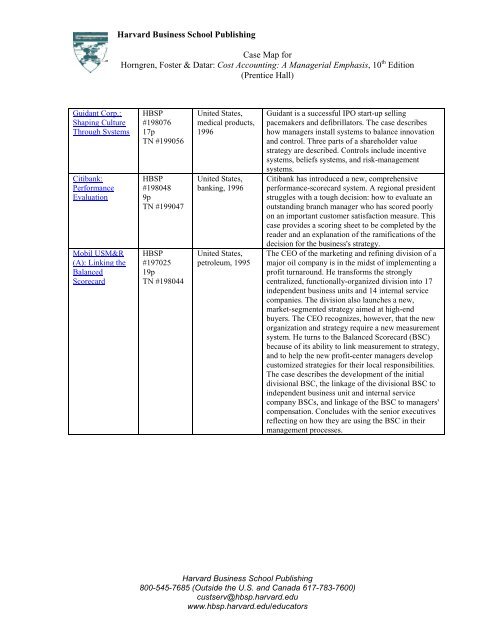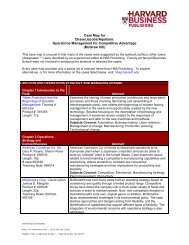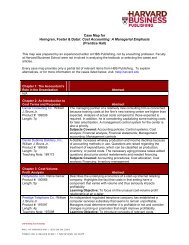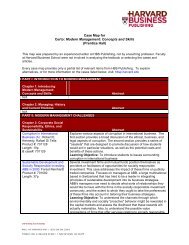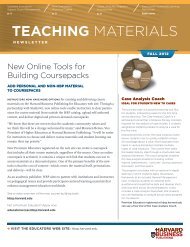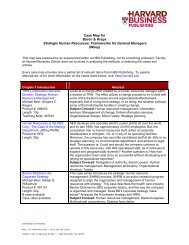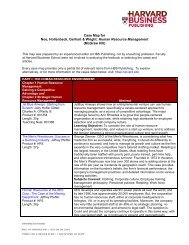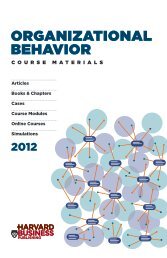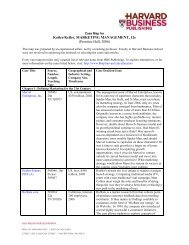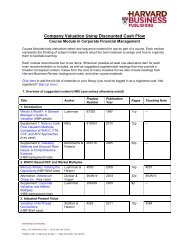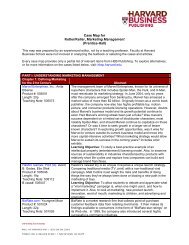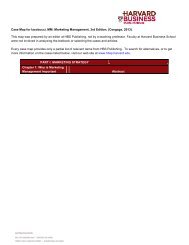Request for Information - Harvard Business School Press
Request for Information - Harvard Business School Press
Request for Information - Harvard Business School Press
You also want an ePaper? Increase the reach of your titles
YUMPU automatically turns print PDFs into web optimized ePapers that Google loves.
Guidant Corp.:<br />
Shaping Culture<br />
Through Systems<br />
Citibank:<br />
Per<strong>for</strong>mance<br />
Evaluation<br />
Mobil USM&R<br />
(A): Linking the<br />
Balanced<br />
Scorecard<br />
<strong>Harvard</strong> <strong>Business</strong> <strong>School</strong> Publishing<br />
Case Map <strong>for</strong><br />
Horngren, Foster & Datar: Cost Accounting: A Managerial Emphasis, 10 th Edition<br />
(Prentice Hall)<br />
HBSP<br />
#198076<br />
17p<br />
TN #199056<br />
HBSP<br />
#198048<br />
9p<br />
TN #199047<br />
HBSP<br />
#197025<br />
19p<br />
TN #198044<br />
United States,<br />
medical products,<br />
1996<br />
United States,<br />
banking, 1996<br />
United States,<br />
petroleum, 1995<br />
Guidant is a successful IPO start-up selling<br />
pacemakers and defibrillators. The case describes<br />
how managers install systems to balance innovation<br />
and control. Three parts of a shareholder value<br />
strategy are described. Controls include incentive<br />
systems, beliefs systems, and risk-management<br />
systems.<br />
Citibank has introduced a new, comprehensive<br />
per<strong>for</strong>mance-scorecard system. A regional president<br />
struggles with a tough decision: how to evaluate an<br />
outstanding branch manager who has scored poorly<br />
on an important customer satisfaction measure. This<br />
case provides a scoring sheet to be completed by the<br />
reader and an explanation of the ramifications of the<br />
decision <strong>for</strong> the business's strategy.<br />
The CEO of the marketing and refining division of a<br />
major oil company is in the midst of implementing a<br />
profit turnaround. He trans<strong>for</strong>ms the strongly<br />
centralized, functionally-organized division into 17<br />
independent business units and 14 internal service<br />
companies. The division also launches a new,<br />
market-segmented strategy aimed at high-end<br />
buyers. The CEO recognizes, however, that the new<br />
organization and strategy require a new measurement<br />
system. He turns to the Balanced Scorecard (BSC)<br />
because of its ability to link measurement to strategy,<br />
and to help the new profit-center managers develop<br />
customized strategies <strong>for</strong> their local responsibilities.<br />
The case describes the development of the initial<br />
divisional BSC, the linkage of the divisional BSC to<br />
independent business unit and internal service<br />
company BSCs, and linkage of the BSC to managers'<br />
compensation. Concludes with the senior executives<br />
reflecting on how they are using the BSC in their<br />
management processes.<br />
<strong>Harvard</strong> <strong>Business</strong> <strong>School</strong> Publishing<br />
800-545-7685 (Outside the U.S. and Canada 617-783-7600)<br />
custserv@hbsp.harvard.edu<br />
www.hbsp.harvard.edu/educators


